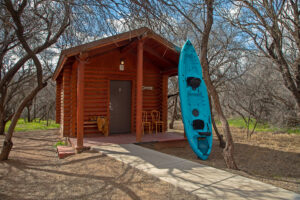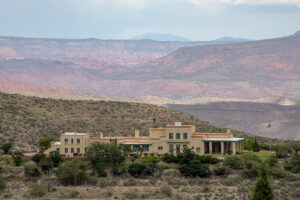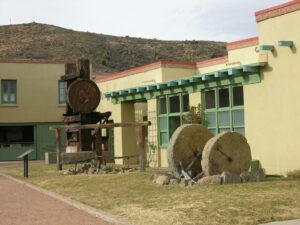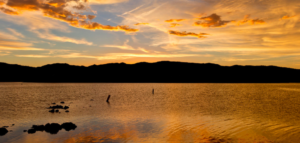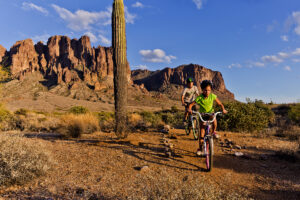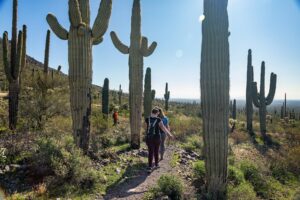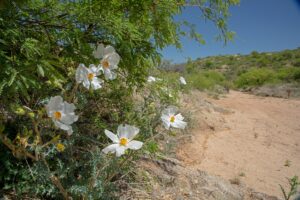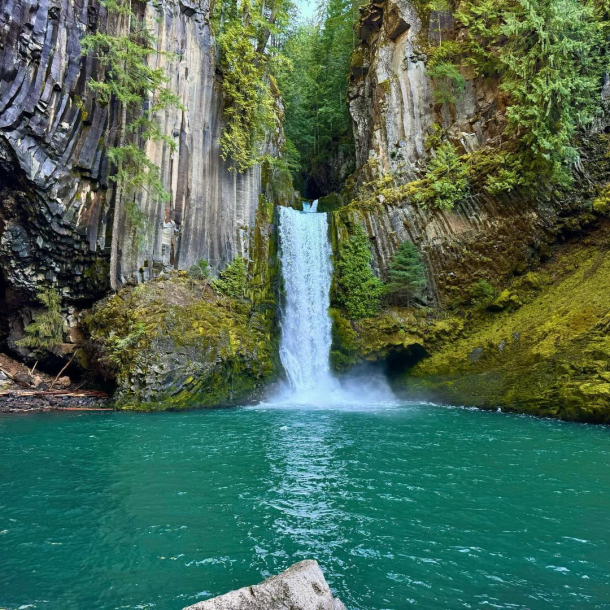Best Arizona State Parks in the Spring
Start / End
Jerome/Phoenix/Tucson
States Covered
Total Distance
431 miles (694 km)
Suggested Days
6-7 days
Suggested Seasons
Spring, Fall, Winter
#ThisIsMyRoute
Getting Started
Itinerary
DEAD HORSE RANCH STATE PARK
Dead Horse Ranch State Park is a beautiful park situated along the Verde River and the Coconino National Forest. Before Dead Horse Ranch became a state park in 1977 it was owned by a family from Minnesota for over 20 years. The man who bought the ranch said that his children named the ranch after they visited for the first time and discovered a dead horse lying by the road. He asked which ranch they liked best and they replied, “the one with the dead horse, dad!” The family requested that the property keep its name when they sold the ranch to become an Arizona state park.
Hiking is the most popular activity at this park, with over 20 miles of non-motorized trails throughout the Dead Horse Trail System. Hikers share the trail with mountain bikers and horseback riders as well. Fishing on the Verde River is popular, as well. Depending on the season, anglers have a chance to catch largemouth bass, rainbow trout, and more. In the spring and winter months the Arizona Game and Fish Department will be stocking the lagoons with trout, and it’s worth checking their schedule to find out when that’ll happen. Dead Horse Ranch State Park offers tent camping, RV camping, and even rustic log cabins for rent.
JEROME STATE HISTORIC PARK
21 MINUTES – 10 MILES/16 KM
Not far from your first stop is the historic town of Jerome and the state park within it. Much like Winslow or Bisbee, Jerome is another one of those quirky, old-west, must-see Arizona towns. Jerome’s story began in the late 1800s when prospectors staked claims on rich copper deposits. By the early 20th century, after a narrow gauge railroad was brought to town, Jerome was able to claim Arizona’s largest producing copper mine. By 1912 there were two mines in Jerome and it was becoming quite the booming town with two churches, an opera house, a school, and several civic buildings. James S. Douglas was the owner of the Little Daisy Mine, and in 1916 he built an adobe mansion on the hill above the Little Daisy, which is now the home of Jerome State Historic Park.
The house was built for his family and as a hotel for mining officials and investors. The mansion had a wine cellar, billiard room, marble shower, steam heat, and even a central vacuum system. Douglas’ former home is now a museum devoted to the history of Jerome and the Douglas family. Visitors can tour the home, admiring photographs, artifacts, video presentations, and more. Enjoy their outdoor picnic area with panoramic views, and be sure to pop over to Audrey Shaft Headframe Park, where visitors can stand on glass above a 1,900 foot shaft. Find lodging in Jerome or drive 20 minutes to your next destination where there’s plenty of camping and even cabins for rent.
ALAMO LAKE STATE PARK
3 HOURS, 15 MINUTES – 167 MILES/269 KM
Driving south from Prescott you’ll feel like you’re truly getting away from it all as you approach Alamo Lake State Park.
Before long, the Bill Williams River Valley will open up before you with a massive, crystal-clear lake surrounded by dramatic mountainous landscapes. This 3,500-acre lake at 1300 feet in elevation is a top destination in the state for bass fishing, birding, and wildflower viewing.
Whether you spend your nights in a cabin or in a campsite, be sure to enjoy the many outdoor recreation opportunities both on the water and on the trails around the lake.
LOST DUTCHMAN STATE PARK
2 HOURS, 50 MINUTES – 171 MILES/275 KM
Your next stop is one of the most eye-catching parks along the route, with stunning views of dramatic, ragged mountains and impressive saguaros in the foreground. Lost Dutchman State Park is named for the Dutchman who never revealed the location of the gold he supposedly found in the Superstition Mountains. To this day, people still go out looking for the hidden treasure in the park. Besides appealing to those hungry for gold, Lost Dutchman State Park is a paradise for hikers, mountain bikers, backpackers, and campers.
If you’re on the hunt for desert wildflowers in the spring, Lost Dutchman will not disappoint. We recommend camping in the park and preparing your camera for an epic sunset. The park also offers camping cabins with undisturbed views of the Superstition Mountains. In addition to exploring the hiking trails, be sure to bring your bike to ride around the perimeter of the park.
PICACHO PEAK STATE PARK
1 HOUR, 30 MINUTES – 73 MILES/117 KM
ORACLE STATE PARK
35 MINUTES – 25 MILES/40 KM
Drive around the backside of the Santa Catalina Mountains to Oracle State Park, just 35 minutes away. Oracle is a day-use only park, but there’s a lot to see so be sure to get there in the morning. After gathering information from the visitors center, take a self-guided tour through the multilevel historic Kannally family home. This mediterranean-revival style ranch house was built from 1929 to 1933 and is now open to the public, showcasing original artwork and Moorish architecture. When you’re finished drooling over the gorgeous desert home, it’s time to hit the trails!
Whether you choose to explore on foot, bike, or horseback, Oracle State Park offers 15 miles of trails. The park is described as 4,000 acres of wildlife refuge, so keep an eye out, especially if you’re visiting in the spring. The elevation ranges from 3,700’ to 4,600’ of high desert landscape, allowing visitors to see anything from white-tailed deer, bobcat, javelina or mountain lions to red tailed hawks and rattlesnakes.





